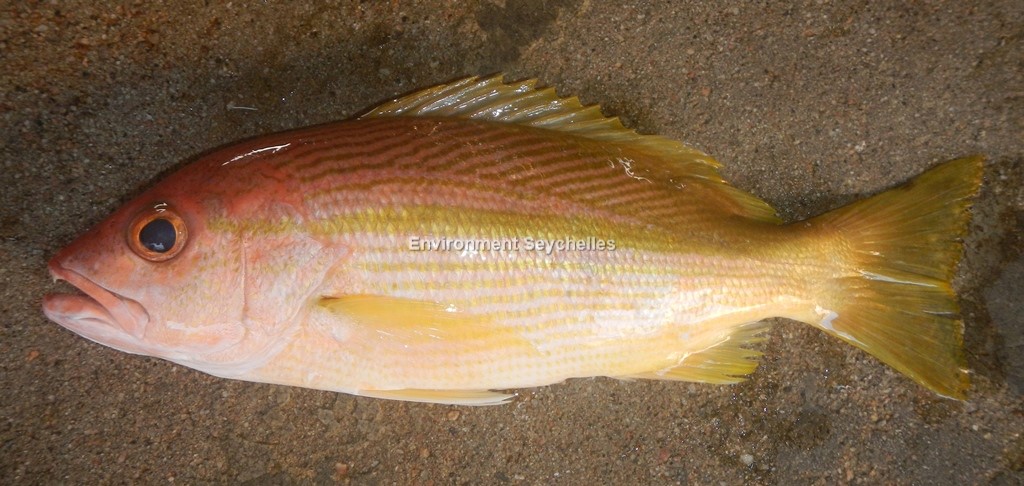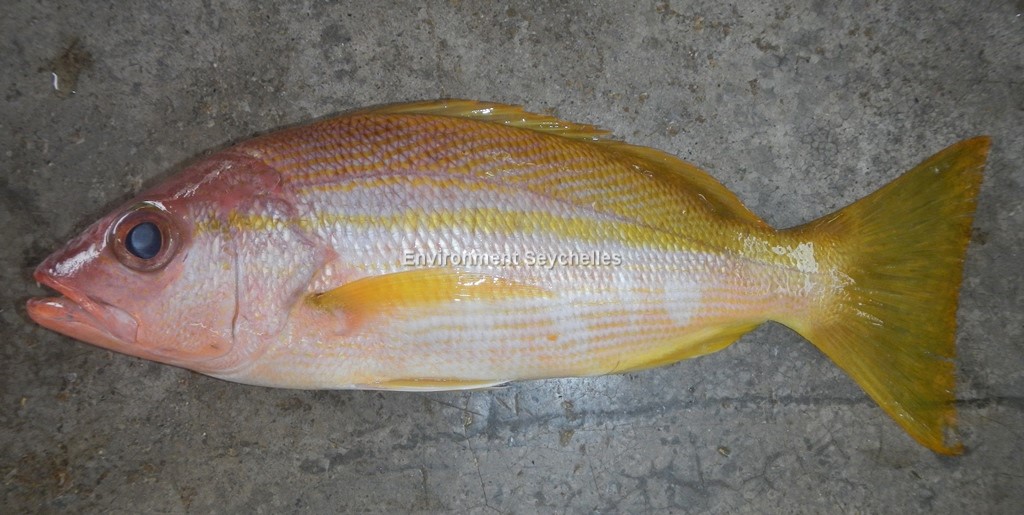Description:
Dorsal spines: 10; Dorsal rays: 13; Anal spines: 3; Anal rays: 9.
Body elongate to moderately deep and laterally compressed. Head relatively small with pointed snout. Snout-forehead profile almost straight. Pair of small rounded nostrils
on each side of snout with very low flap on outer edge of anterior nostril. Pair of canine teeth anteriorly in upper jaw, with smaller canine teeth between these and
symphysis. Remaining lateral portion of upper jaw with series of embedded caniniform teeth. Lower jaw with about 6‒8 small canine teeth on each side. Dorsal-fin outline
slightly incised. Predorsal scales extending forward to vertical at posterior margin of pupil. Scale rows on back rising obliquely above lateral line. Lateral-line scales
49–51. Horizontal scale rows above lateral line 6–7. Scale rows on cheek 7–8. Scales absent on preopercular flange. Profile of soft dorsal-fin relatively low and weakly
rounded. Pectoral fins pointed. Caudal fin emarginate.
Colour. Pinkish-white base colour, becoming darker reddish-pink dorsally and down snout, and paler ventrally. A series of narrow yellow horizontal stripes (one per scale row)
on lower sides of body below the lateral line. The mid-lateral stripe originating at the mid-eye distinctly more prominent and wider, 1.5‒3 scale rows wide. Similar thin
yellow to brownish yellow lines above lateral line, but run obliquely upward and along oblique scale rows. Dorsal, caudal, anal, and pectoral fins yellow (caudal fin
frequently dusky when fresh). Pelvic fins whitish with yellow tinge. Iris reddish to golden yellow.
Size:
Maturity: Lm unknown. Range unknown. Max Length: 30 cm TL, Commonly to 20 cm TL.
Habitat and Ecology:
Inhabits coastal coral and rocky reefs and outer slopes (depth 5-90 m). Forms large and small aggregations around outcrops. Diurnal carnivore. It is a broadcast spawner and
tends to spawn in groups.
Fishery Status:
This species is not protected or subject to fishery regulations. It is caught in the fish trap fishery and is a regular and sometimes numerous component of the catch.
Notes:
L. madras is 1 of 7 species in the Yellow-lined snapper complex. L. vitta and L. Lutjanus are also documented as occurring in Seychelles (Allen 1984, 1985) and can be
distinguished from L. madras as per the characteristics tabulated below (adapted from Iwatsuki 2015).
|
Lutjanus madras, L. Lutjanus and L. vitta selected character comparison |
|||
|
|
L. lutjanus |
L. madras |
L. vitta |
|
Dorsal fin rays |
XII, 12 |
X, 13 |
X, 12-13 |
|
Anal fin rays |
III,8 |
III,9 |
III,8 |
|
Scale rows on cheek. |
5-8 |
7 or 8 |
5-7 |
|
Horizontal scale rows above lateral line. |
4 or 5 |
7 or 8 |
8-10 |
|
Preopercular flange |
Scaled |
No scales |
Scaled |
|
|
|
|
|
References:
Allen, G.R. (1984). Lutjanidae. In W. Fischer and G. Bianchi (eds.) FAO species identification sheets for fishery purposes. Western Indian Ocean (Fishing Area 51) volume 3. [var. pag.]. FAO, Rome.
Allen, G.R. (1985). FAO Species Catalogue. Vol. 6. Snappers of the world. An annotated and illustrated catalogue of lutjanid species known to date. FAO Fish. Synop. 125(6):208 p. Rome: FAO.
Froese, R. & D. Pauly. (Eds.) (2020). FishBase. https://www.fishbase.in/summary/Lutjanus-madras (12/05/20).
Iwatsuki, Y. et al. (2015). Lutjanus xanthopinnis, a new species of snapper (Pisces: Lutjanidae) from the Indo-west Pacific, with a redescription of Lutjanus madras
(Valenciennes 1831). Journal of the Ocean science Foundation 2015, Vol 17.
Russell, B. et al. (2019). Lutjanus madras. The IUCN Red List 2019: https://dx.doi.org/10.2305/IUCN.UK.2019-2.RLTS.T194369A2323814.en. (12/05/20).
Citation:
Nevill, J.E.G. (2020). Lutjanus madras, Indian snapper. Seychelles Seatizens. www.seatizens.sc. https://seatizens.sc/species/lutjanus-madras-valenciennes-1831/ (edited 20/07/22).




There are no comments